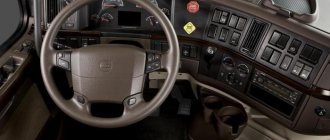Machine Operational Advantages
The Volvo fm 12 performs excellently in quarry conditions, holding the road and being an excellent machine to drive. The presence of power steering makes control very convenient and simple for a professional driver. However, when using a trailer, the Volvo fm 12 begins to have some problems: the engine operates at maximum speed, while the weight of the vehicle is maximum. With a trailer, driving becomes much more difficult, especially when there are difficult weather conditions, high humidity and precipitation. Under such circumstances, the Volvo fm tractor begins to show character and resist the wet road, sliding along the ground.
Background
The Volvo FM family of trucks has existed since 1998. Today, the third series of vehicles are already plying the roads of Europe and the CIS.
The first-born of the Swedish auto giant also regularly rack up kilometers, although more on our roads. FM models win the hearts of drivers from the first trip: the trucks turned out to be obedient and reliable. The progenitor of the FM series was the successful FL7 model, whose history dates back to the 80s of the last century. This model was offered to the market in a variety of variants and modifications for 20 years. The principles laid down in the design of the FL7 have become fundamental for Volvo in their modern work: the company has ensured that the truck, in fact, has become a designer that can be modernized without problems.
Reviews about the car
Reviews from truck drivers say that driving a loaded vehicle without a trailer is ideal, even in rainy weather and high dampness. However, handling becomes significantly more difficult with the additional cargo of a full trailer. There are only positive words about the driver’s comfort in the cabin, since the manufacturer is concerned about the comfort of the truck driver. Climate control and the presence of a stove are only part of the comfortable components of the cabin, not to mention the attractive interior and comfortable seats. According to driver reviews of the FM 12, the dump truck has excellent characteristics.
Test drive: Volvo FM
/19.01.14/
In the fall, in Gothenburg, journalists were presented with a new truck for regional transportation - Volvo FM. Perhaps the premiere of the youngest of the long-distance trucks went unnoticed by the general public, if not for Van Damme’s epic splits. At first there were millions of views on YouTube, then the clip was shown on all central channels without exception. I can imagine that even housewives who saw the video wondered how this was possible in principle? Simultaneously with the show, the traffic of visitors to our website increased, who were looking for an answer to what kind of Volvo Dynamic Steering system it is, which allows it to perform miracles. You will also learn about it by reading this material to the end.
What made me sit down to write this review was the surprisingly short time it took for the new Volvo FM to appear on the Russian market. Even passenger cars didn’t reach us so quickly, which means it’s time to introduce the reader to a new product. The Volvo FM series of heavy trucks dates back to 1998. Due to its steady demand, the car has fallen under the designer's knife for the fourth time. Until 2005, its index contained the following numbers: FM7, FM10, FM12, which determined the size of the installed engine in liters. The Latin letters “FM” denoted Volvo’s internal ranking. Where F is a cabover truck, and M is the cabin size (from the Latin medium). Now the numbers have disappeared, and the FM line has become the longest in Volvo's line. It includes both medium-haul trucks and city construction and delivery vehicles.
The updated FM is recognizable and has the family features of Volvo Trucks. The cabin frame appears to have remained the same, with the sloping windshield and side moldings giving off a familiar silhouette. The nose, on the contrary, is completely consistent with the design of the flagship FH. Drivers will appreciate the new bumper and convenient step for access to the windshield and wipers. Environmental standards require greater air flow into the engine compartment, which is reflected in the radiator grille - it has clearly increased in size. The picture of the front end is complemented by characteristic, slanted headlights with the ability to illuminate the turning area and an enlarged emblem.
Half measures, not typical for Volvo Trucks, now I mean the frame from the previous model, are explained by savings. And above all, saving money for the client. Before writing the article, I set out to find out how much a new truck would cost for a domestic carrier. After several calls and letters to the company's central office, I was able to find out that the price of the new Volvo FM relative to the previous model has increased by only 3-4%, depending on the configuration. For those who do not consider this an idle question, it is easy to calculate that the cost has increased within the limits of general inflation. That is, an almost new truck remains in the same price category.
The driver's working area is maximally identified with the flagship model. The new dashboard and instrument cluster are perfectly readable in any light. A well-thought-out and logically designed workplace with a convenient layout of buttons and controls, made in a truly Scandinavian style. Nothing superfluous and everything is at hand. The steering column is tilt adjustable using a floor pedal. A new seat design provides improved lateral and lumbar support, while the ignition key receptacle has been moved closer to the instrument panel for increased legroom.
Volvo FM trucks are equipped with four types of cabs. In each of them, even more space has been created for storing various items without which not a single working day can be completed. Documents, delivery notes, keys and cards, as well as personal belongings, for all this there is a glove compartment, pocket and shelf. The most spacious of them is shown in the photo - the Globetrotter XL has an internal height of 2.1 m and capacious storage compartments above the windshield and on the rear wall of the cabin. This design is for one driver with a single sleeping berth.
One of the most pleasant little things on the new Volvo FM that can brighten up the hard work of a truck driver is the remote control. It makes loading easier and makes it easier to work outside the cab. Thanks to the wireless remote control device, the driver always knows how much the load weighs and how the load is distributed along the axles. It can be used to carry out a number of other operations, thanks to which the driver does not need to constantly leave the cab.
The test Volvo FMs were equipped with two types of diesel engines meeting the Euro 6 environmental standard. These are 10.8-liter D11 engines with a capacity of 330 - 450 hp. s., and D13 with a working volume of 12.8 liters. with a power of 420 - 500 hp. p.. The in-line six-cylinder D13 engines, familiar to us from the FH and FMX series, are equipped with pump injectors and an SCR catalytic exhaust system using AdBlue. In order to meet environmental standards, an EGR exhaust gas recirculation system with a DRF particulate filter is used.
The EGR exhaust gas recirculation system on new engines is used mainly to increase the temperature of the exhaust gases. In the event that the engine is not warm enough to raise the exhaust temperature to at least 250 °C for the SCR system to function optimally. On Euro 6 engines, when driving at cruising speed, the EGR system is practically inactive, which does not have a negative impact on fuel consumption during operation. On D11 engines, a common rail injection system with an operating pressure of 2000 bar is used. In addition to the fact that the motors are distinguished by their efficiency, a significant reduction in noise was noted during their operation.
Before the upcoming test drive, all participants were given accreditation badges on which the purpose of our trip could be read. Driving Impression, which translated into Russian means “Driving Impression”. Just an impression, because you can’t count on more. In one day, the manufacturer tries to load journalists with as much information as possible, plus a mandatory test drive. This time I again had the chance to get behind the wheel of a Scandinavian hitch with a total weight of 60 tons and a length of 25.25 meters. The tractor was a Volvo FM truck with a 6x2 wheel arrangement and a 500 hp engine, with a dolly dolly, to which a standard semi-trailer was in turn attached. This type of hitch is recognized as the safest and most stable of all long hitches of the 25.25 standard. This is due to the long wheelbase of the tractor in combination with the huge base of the dolly and semi-trailer. The mass of ballast loaded into the test road train was 34 tons!
This was not the first trip on public roads in Sweden. Curiosity and contemplation of the Scandinavian landscapes had been satisfied earlier, so it was possible to fully experience the available options. And here I first tried adaptive cruise control paired with the I-See system. It scans the route's inclines and descents and adjusts the transmission and engine brake to provide better fuel efficiency. I won’t lie, in relatively dense traffic, it took me a lot of effort not to use the brake pedal. And if it weren’t for the persistent actions of the instructor, I would never have believed that a 60-ton colossus was capable of tracking the actions of drivers of passenger cars that came across my path.
Moreover, thanks to the Forward Collision Warning system, with a built-in camera and radar, the computer stopped the road train and assessed the road situation within the lane just as well as I did. When braking, the VEB+ engine brake is activated and on the D13 engine it produces an impressive 375 kW (510 hp). The most powerful engine in the FM line, a 500-horsepower engine, coped with the small climbs along which our route passed. I'm sure its power is enough for a standard hitch. However, I wouldn’t risk going to real mountains in winter with such a package (60 tons). For these conditions, Volvo Trucks creates more adaptable and powerful trucks, such as the Volvo FH 16.
To save space, the I-Shift control mechanism has been moved to the dashboard. The keys are in the photo at the top right.
And finally, let's return to where this review began. The unique Volvo Dynamic Steering system, which made it possible to film a video starring Van Damm that caused so much noise. It is a combination of a hydraulic booster with an electronically controlled electric motor built into it. When driving on a flat road, the system does not reveal its presence; on the test truck I could only observe a light and at the same time informative steering wheel. The system activates when more difficult conditions begin: crosswind gusts, frequent bumps and potholes, or reversing. VDS automatically compensates for steering forces and activates the vehicle's automatic centering function. Perhaps the principle of its operation will remain a mystery to many, but I am sure that soon the option will be appreciated.
Volvo Trucks continues to focus on the versatility and economics of its transport business. The new Volvo FM is a universal model that can be easily adapted to the requirements of any customer. There are hundreds of configuration options! In conclusion, I will quote what President Claes Nilsson said at the presentation of the new model: “To use football terminology, the FM is an invaluable all-round player who excels in any position.”
VIDEO Test drive Volvo FM
Text, photo and video: Valery Pisanov
Specifications
The Volvo fm 12 is equipped with everything necessary for transporting various cargoes and building materials. Let's look at the main technical characteristics of the truck.
| Load capacity | 15/20 tons |
| Maximum speed | Limit - 90 km/h |
| Machine weight | 32 tons |
| Wheelbase | 3400-5100 millimeters |
| Engine power | 330-540 l. With. |
| Fuel type | DT |
| Number of engine cylinders | 6 |
| Engine model | D13C, Euro 5 and Euro 6 certified |
| Suspensions (front and rear) | Parabolic and multi-leaf respectively |
| Brake system type | Drums |
| Fuel tank volume | 400 liters |
| Rechargeable batteries | 2 units of 225 A/h |
| Additionally | Climate control, ABS, heating |
| Model | Volvo FM 12 |
Everything new raises questions
In the latest generation Volvo FM, the main changes affected the propulsion system: new 11 and 13 liter diesel engines are installed on the car, with 8 power options: from 330 to 500 hp. The introduced dynamic steering system is designed to improve both handling comfort and driving precision. On the official Volvo website they claim that a car with a trailer with such a control system can reverse for almost a hundred meters without deviating from the trajectory. Moreover, the driver doesn’t even have to hold the steering wheel!
During the work, the new FM was closely matched to its “big brother” FH in terms of design and comfort. Among the conveniences: the running boards on the bumper, which you can stand on when cleaning the glass, are now covered with anti-slip material.
Doubtful: all front lighting equipment is now made of plastic. Resistance to mechanical damage certainly increases. But the yellowness and cloudiness that occurs over time are very annoying: replacing or cleaning clouded plastic is expensive.
A lyrical digression on the topic: “I gave birth to you, I will develop you.” FM is increasingly reminiscent of FH, and not only in appearance. Back in the early 2000s, Volvo began to worry that the car would take away part of the market from the FH series, designed for long-distance transportation. To slow down this process, FM began to be equipped with less powerful engines. But consumers were unstoppable: FM thoroughly occupied the niche of regional and interregional transportation, both over medium and long distances. Now the concern's engineers are forced to follow the lead of consumers: the “youngest” has received new, enlarged fuel tanks.
Truck description
The Volvo fm 12 tractor fully complies with operating conditions. Body volumes range from 16-20 cubic meters, which is more than enough to solve professional problems. The 6x4 layout is suitable for construction using the first body option, while the 20 cubic meter body is suitable for use in quarry conditions.
The Volvo fm 12 tractor is equipped with a 13-liter engine. Each cylinder of the power unit has 4 valves and a pump injector. Separately, it is worth noting the electronic control. The management of the manufacturer pursues a progressive development policy, thanks to which various components of the Volvo fm 12 are constantly being modernized, opening up great opportunities for truck drivers. The first modifications of power units complied with Euro-3 certification, the latest versions are already certified according to Euro-5 and Euro-6 standards. Features worth knowing:
- Cars assembled in Kaluga are equipped with D13A engines with a power of 400 hp. With.
- In domestically produced cars, the engine complies with Euro-4 standards
- A special seal does not allow you to exceed the maximum speed limit, set at 90 km/h
- If we talk about the cost of the truck, an FM 12 dump truck will cost the buyer between 3.5-4.5 million rubles.
The description of the features of Russian-made trucks includes a 14-speed manual transmission.
Separately, it is worth noting the long-term operation of the gearbox without the need for repairs, which was made possible thanks to the cooling system and correct operating conditions.
The front suspension of the tractor is parabolic, while the rear is multi-leaf. Anti-roll bars are included. There are power windows, electric air conditioning, heated mirrors. Among the pleasant features is the automatic adjustment of headlights - set the illumination of the road surface individually. The kit includes a 20-ton jack, reflective vests, tools necessary for repairs, a set of road signs, and a 20-meter hose for inflating wheels.
A complete list of additional options is specified in the car manual. Electrical equipment is also indicated there.
It is worth mentioning that additional features include preparation for lighting, the total power of which is no more than 300 W.
The manufacturing company’s engineers continue to improve and modernize the equipment produced under the brand. The changes did not bypass the fuel system of the fm 12 tractor. The manufacturer installs a system that provides comprehensive heating of the vehicle components and mechanisms involved in the transportation of fuel.
Owner reviews: almost everything is good
The first generation is distinguished by great reliability and ease of maintenance: there are practically no electronics, driver comfort is very high even in modern times, spare parts are inexpensive. The cost of these cars today fluctuates around 10-15 thousand euros. The engines are striking in their reliability: owners of “millionaire” engines, untouched by the hands of mechanics, can be found on every third such machine.
Second generation. The cars are also considered reliable. But not for our roads and fuel. The transition of Europeans to Euro-4 and Euro-5 standards has caused the need to change engines on these models more often than once every 5 years. Accordingly, the quality of fuel for these models should be higher. In our latitudes, the operation of these machines showed that there was no high-quality “solarium” - and still isn’t. Repair of fuel equipment remains the most popular for the second generation FM. The design and comfort of this series are unrivaled. The price of a car can fluctuate around 20-40 thousand euros.









